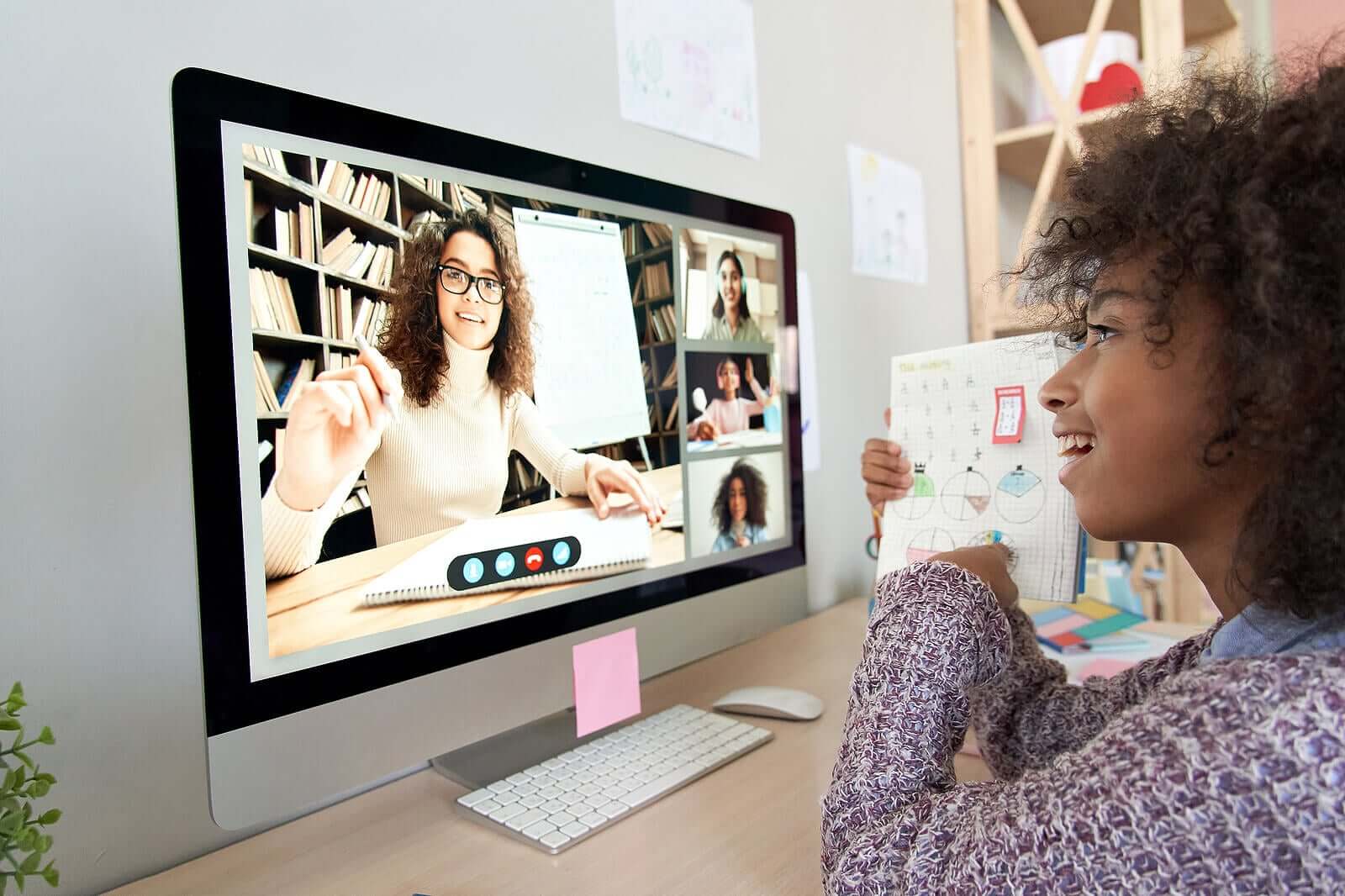3 Quotes from Salman Khan about Children's Education

By now, you’ve probably already heard of the Khan Academy platform, as it’s behind the education of millions of children and adolescents in the world. But if you haven’t, don’t worry! Salman Khan, the very creator of this model, tells you 3 ideas to improve the education of children in his TED conference. Let’s look at them together!
Salman Khan and his “Khan Academy”
Salman Amin Khan was born in the United States of America in 1976. He had an Indian mother and a Bangladeshi father. Years later, he graduated from the Massachusetts Institute of Technology (MIT) in Computer Science, Electronic Engineering, and Mathematics.
While working as a mutual fund manager in Boston, he decided to help his cousins with math online. To fulfill this mission, he would upload videos for them on YouTube that he himself recorded with entertaining explanations about the subject.
His content was so good that it quickly went viral, and in 2005, Khan created a completely free online learning organization. This was called the Khan Academy.
Currently, this organization has the contribution of more than 150 professionals, including developers, teachers, designers, and education specialists who seek to inspire the world to learn.
Khan Academy offers practice exercises, instructional videos, and personalized tutorials in various subjects, such as mathematics, physics, chemistry, biology, science, economics, history, among others.
Its reach is global and has more than 42 million registered users from more than 190 countries. For this reason, the platform is translated into 50 languages.
Activities and educational resources are available on the Khan Academy website for children from the first years of elementary school to young people who are finishing high school.
Thanks to his creativity, his mission, and his global reach, in 2019 Salman Khan received the Princess of Asturias Award for Cooperation.

Learn more about Salman Khan with these famous quotes
If you still do not know what his methodology’s about, pay attention to the following premises of the creator himself.
1. “Let’s use video to reinvent education”
Salman Khan says that using carefully structured educational videos makes learning easier.
He mentions that when a student uses this resource, they can repeat it as many times as necessary to achieve a better understanding. This way, they can advance their learning at their own pace and without emotional pressure.
In addition, Khan highlights the power of interactive exercises and invites teachers to change their methodology in the classroom.
Also, he promotes the use of video classes to watch at home and carry out academic activities in the classroom with a teacher who guides the learning. This concept is called “flipped classroom” and according to Khan, it allows the teacher to humanize the classroom in interaction and social learning.
Neuroscientist Francisco Mora points out that repetition and emotion encourage learning. When a new concept is learned, it has to be anchored in previous knowledge. and in this sense, reiterations are key.
Another fundamental aspect that makes videos so attractive is the fact that they are part of digital education. This modality allows the student to get excited and holds their attention with greater interest.
The videos also combine simple language with effects, animations, and humor. All this allows the student to have fun while learning more fluently and easily.
2. “Learn math the way you learn anything”
Khan tells us that one can learn mathematics just as one learns to ride a bicycle. Hearing these words makes the subject feel like something easy to incorporate.
If we follow the previous example, we’ll better understand the idea. When you learn to ride a bicycle, you fall down and try again as many times as necessary until you’ve mastered the technique. Right? Well, the same thing must happen with mathematics: You need to try again in an entertaining way until you master it.
So why are so many students having a hard time learning this subject? Basically, because they’re not given the time or opportunity for repetition, exercise, and real learning. This, according to Salman Khan himself.
The creator of the academy is concerned about the current education that children receive and points out that the traditional teaching model punishes the student when they experiment and fail. In addition, it doesn’t demand the need to master knowledge.
For this reason, Salman Khan invites the student to experiment and fail until mastering the subject.
How can a great building be built without solid foundations? It can’t. So, can we help students to like math and learn it more easily? Yes, we can!
Neurosciences tell us that learning is achieved with direct experience, multisensory exploration, repetition, and trial and error, among others. It’s also known that any school experience or activity that¡s presented in a fun way (preferably with a playful approach) will be pleasant and will positively affect children’s learning.
So, math should be learned step by step and also, with some fun.
3. “Our goal is to use technology to humanize education”

Khan notes that much of his academy’s effort is put into humanizing the classroom and focusing on the “student-time-teacher” ratio.
Therefore, in a traditional model, most of the school day, the teacher is the one who teaches, evaluates, and qualifies the students. Perhaps only 5% of the time is spent sitting with your students and accompanying them in their own learning process.
When a teacher uses technology, they not only inverts the classroom, they also humanize it. This statement is based on the following concepts:
- The student progresses at their own pace.
- They start managing the time they have.
- Students identify what they know or don’t know in a more spontaneous and direct way.
- Cooperation between student learners and teachers who teach is encouraged.
- The teacher accompanies without question.
Neurosciences endorse these premises and agree that they encourage learning. This is because they’re directly related to fundamental aspects, such as personal motivation, self-esteem, self-identification of prior knowledge, and social learning.
For this reason, the idea of using educational applications for teaching children is increasingly consolidated. We can’t deny that we’re immersed in the digital age of Information and Communication Technologies (ICTs).
Learning should be fun
Learning should be enjoyed, regardless of the age of the child. Therefore, if you agree that Salman Khan’s phrases regarding education are key, you can’t miss the following web resources:
- EduClan: is an educational tool with audiovisual content for children from 3 to 10 years old, created as an initiative for learning during quarantine.
- eHomeKids: is a didactic portal with free digital educational resources for children from 3 to 5 years old.
By now, you’ve probably already heard of the Khan Academy platform, as it’s behind the education of millions of children and adolescents in the world. But if you haven’t, don’t worry! Salman Khan, the very creator of this model, tells you 3 ideas to improve the education of children in his TED conference. Let’s look at them together!
Salman Khan and his “Khan Academy”
Salman Amin Khan was born in the United States of America in 1976. He had an Indian mother and a Bangladeshi father. Years later, he graduated from the Massachusetts Institute of Technology (MIT) in Computer Science, Electronic Engineering, and Mathematics.
While working as a mutual fund manager in Boston, he decided to help his cousins with math online. To fulfill this mission, he would upload videos for them on YouTube that he himself recorded with entertaining explanations about the subject.
His content was so good that it quickly went viral, and in 2005, Khan created a completely free online learning organization. This was called the Khan Academy.
Currently, this organization has the contribution of more than 150 professionals, including developers, teachers, designers, and education specialists who seek to inspire the world to learn.
Khan Academy offers practice exercises, instructional videos, and personalized tutorials in various subjects, such as mathematics, physics, chemistry, biology, science, economics, history, among others.
Its reach is global and has more than 42 million registered users from more than 190 countries. For this reason, the platform is translated into 50 languages.
Activities and educational resources are available on the Khan Academy website for children from the first years of elementary school to young people who are finishing high school.
Thanks to his creativity, his mission, and his global reach, in 2019 Salman Khan received the Princess of Asturias Award for Cooperation.

Learn more about Salman Khan with these famous quotes
If you still do not know what his methodology’s about, pay attention to the following premises of the creator himself.
1. “Let’s use video to reinvent education”
Salman Khan says that using carefully structured educational videos makes learning easier.
He mentions that when a student uses this resource, they can repeat it as many times as necessary to achieve a better understanding. This way, they can advance their learning at their own pace and without emotional pressure.
In addition, Khan highlights the power of interactive exercises and invites teachers to change their methodology in the classroom.
Also, he promotes the use of video classes to watch at home and carry out academic activities in the classroom with a teacher who guides the learning. This concept is called “flipped classroom” and according to Khan, it allows the teacher to humanize the classroom in interaction and social learning.
Neuroscientist Francisco Mora points out that repetition and emotion encourage learning. When a new concept is learned, it has to be anchored in previous knowledge. and in this sense, reiterations are key.
Another fundamental aspect that makes videos so attractive is the fact that they are part of digital education. This modality allows the student to get excited and holds their attention with greater interest.
The videos also combine simple language with effects, animations, and humor. All this allows the student to have fun while learning more fluently and easily.
2. “Learn math the way you learn anything”
Khan tells us that one can learn mathematics just as one learns to ride a bicycle. Hearing these words makes the subject feel like something easy to incorporate.
If we follow the previous example, we’ll better understand the idea. When you learn to ride a bicycle, you fall down and try again as many times as necessary until you’ve mastered the technique. Right? Well, the same thing must happen with mathematics: You need to try again in an entertaining way until you master it.
So why are so many students having a hard time learning this subject? Basically, because they’re not given the time or opportunity for repetition, exercise, and real learning. This, according to Salman Khan himself.
The creator of the academy is concerned about the current education that children receive and points out that the traditional teaching model punishes the student when they experiment and fail. In addition, it doesn’t demand the need to master knowledge.
For this reason, Salman Khan invites the student to experiment and fail until mastering the subject.
How can a great building be built without solid foundations? It can’t. So, can we help students to like math and learn it more easily? Yes, we can!
Neurosciences tell us that learning is achieved with direct experience, multisensory exploration, repetition, and trial and error, among others. It’s also known that any school experience or activity that¡s presented in a fun way (preferably with a playful approach) will be pleasant and will positively affect children’s learning.
So, math should be learned step by step and also, with some fun.
3. “Our goal is to use technology to humanize education”

Khan notes that much of his academy’s effort is put into humanizing the classroom and focusing on the “student-time-teacher” ratio.
Therefore, in a traditional model, most of the school day, the teacher is the one who teaches, evaluates, and qualifies the students. Perhaps only 5% of the time is spent sitting with your students and accompanying them in their own learning process.
When a teacher uses technology, they not only inverts the classroom, they also humanize it. This statement is based on the following concepts:
- The student progresses at their own pace.
- They start managing the time they have.
- Students identify what they know or don’t know in a more spontaneous and direct way.
- Cooperation between student learners and teachers who teach is encouraged.
- The teacher accompanies without question.
Neurosciences endorse these premises and agree that they encourage learning. This is because they’re directly related to fundamental aspects, such as personal motivation, self-esteem, self-identification of prior knowledge, and social learning.
For this reason, the idea of using educational applications for teaching children is increasingly consolidated. We can’t deny that we’re immersed in the digital age of Information and Communication Technologies (ICTs).
Learning should be fun
Learning should be enjoyed, regardless of the age of the child. Therefore, if you agree that Salman Khan’s phrases regarding education are key, you can’t miss the following web resources:
- EduClan: is an educational tool with audiovisual content for children from 3 to 10 years old, created as an initiative for learning during quarantine.
- eHomeKids: is a didactic portal with free digital educational resources for children from 3 to 5 years old.
All cited sources were thoroughly reviewed by our team to ensure their quality, reliability, currency, and validity. The bibliography of this article was considered reliable and of academic or scientific accuracy.
- Belloch, C. (2012) Las Tecnologías de la Información y Comunicación en el aprendizaje. Universidad de Valencia. España
- Khan, S. (2019) La escuela del mundo: una revolución educativa. Madrid: Ariel
- Mora, F. (2013) Neuroeducación. Madrid: Alianza Editorial
- eHomekids. [Internet]. Disponible en: https://www.ehomekids.com/
This text is provided for informational purposes only and does not replace consultation with a professional. If in doubt, consult your specialist.








